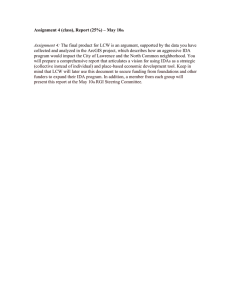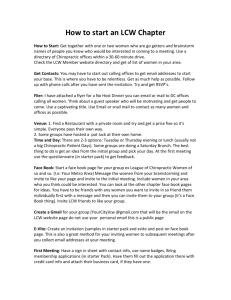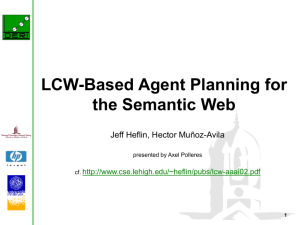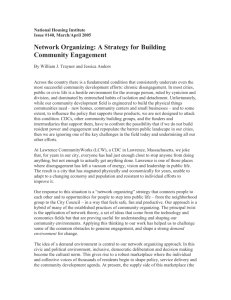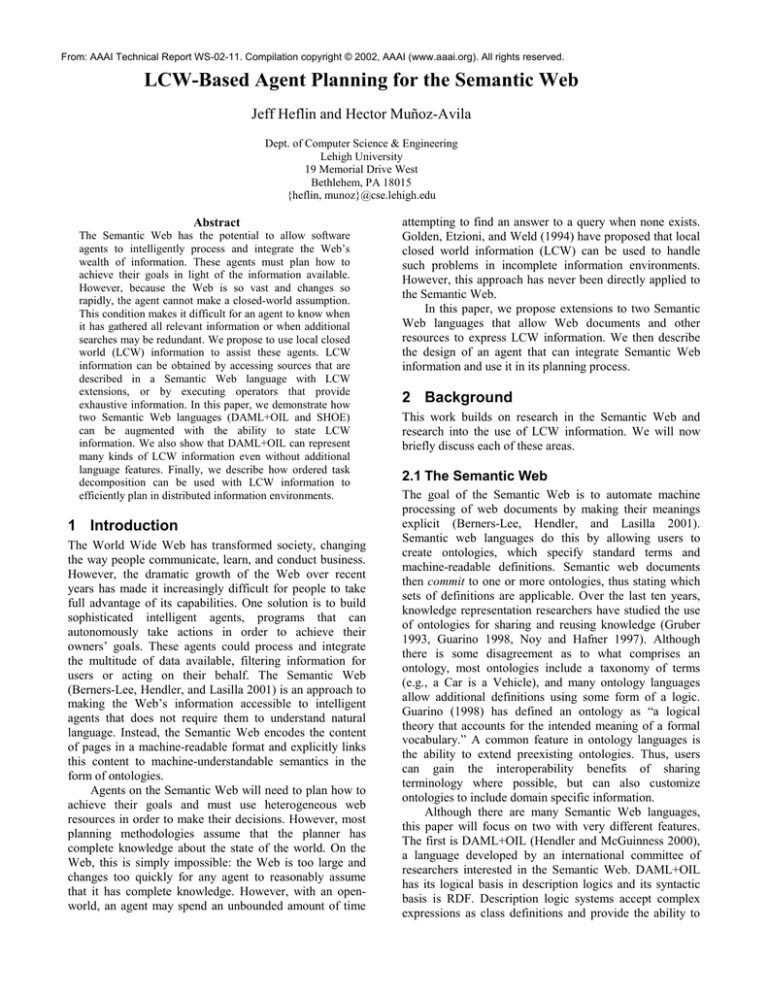
From: AAAI Technical Report WS-02-11. Compilation copyright © 2002, AAAI (www.aaai.org). All rights reserved.
LCW-Based Agent Planning for the Semantic Web
Jeff Heflin and Hector Muñoz-Avila
Dept. of Computer Science & Engineering
Lehigh University
19 Memorial Drive West
Bethlehem, PA 18015
{heflin, munoz}@cse.lehigh.edu
Abstract
The Semantic Web has the potential to allow software
agents to intelligently process and integrate the Web’s
wealth of information. These agents must plan how to
achieve their goals in light of the information available.
However, because the Web is so vast and changes so
rapidly, the agent cannot make a closed-world assumption.
This condition makes it difficult for an agent to know when
it has gathered all relevant information or when additional
searches may be redundant. We propose to use local closed
world (LCW) information to assist these agents. LCW
information can be obtained by accessing sources that are
described in a Semantic Web language with LCW
extensions, or by executing operators that provide
exhaustive information. In this paper, we demonstrate how
two Semantic Web languages (DAML+OIL and SHOE)
can be augmented with the ability to state LCW
information. We also show that DAML+OIL can represent
many kinds of LCW information even without additional
language features. Finally, we describe how ordered task
decomposition can be used with LCW information to
efficiently plan in distributed information environments.
1 Introduction
The World Wide Web has transformed society, changing
the way people communicate, learn, and conduct business.
However, the dramatic growth of the Web over recent
years has made it increasingly difficult for people to take
full advantage of its capabilities. One solution is to build
sophisticated intelligent agents, programs that can
autonomously take actions in order to achieve their
owners’ goals. These agents could process and integrate
the multitude of data available, filtering information for
users or acting on their behalf. The Semantic Web
(Berners-Lee, Hendler, and Lasilla 2001) is an approach to
making the Web’s information accessible to intelligent
agents that does not require them to understand natural
language. Instead, the Semantic Web encodes the content
of pages in a machine-readable format and explicitly links
this content to machine-understandable semantics in the
form of ontologies.
Agents on the Semantic Web will need to plan how to
achieve their goals and must use heterogeneous web
resources in order to make their decisions. However, most
planning methodologies assume that the planner has
complete knowledge about the state of the world. On the
Web, this is simply impossible: the Web is too large and
changes too quickly for any agent to reasonably assume
that it has complete knowledge. However, with an openworld, an agent may spend an unbounded amount of time
attempting to find an answer to a query when none exists.
Golden, Etzioni, and Weld (1994) have proposed that local
closed world information (LCW) can be used to handle
such problems in incomplete information environments.
However, this approach has never been directly applied to
the Semantic Web.
In this paper, we propose extensions to two Semantic
Web languages that allow Web documents and other
resources to express LCW information. We then describe
the design of an agent that can integrate Semantic Web
information and use it in its planning process.
2 Background
This work builds on research in the Semantic Web and
research into the use of LCW information. We will now
briefly discuss each of these areas.
2.1 The Semantic Web
The goal of the Semantic Web is to automate machine
processing of web documents by making their meanings
explicit (Berners-Lee, Hendler, and Lasilla 2001).
Semantic web languages do this by allowing users to
create ontologies, which specify standard terms and
machine-readable definitions. Semantic web documents
then commit to one or more ontologies, thus stating which
sets of definitions are applicable. Over the last ten years,
knowledge representation researchers have studied the use
of ontologies for sharing and reusing knowledge (Gruber
1993, Guarino 1998, Noy and Hafner 1997). Although
there is some disagreement as to what comprises an
ontology, most ontologies include a taxonomy of terms
(e.g., a Car is a Vehicle), and many ontology languages
allow additional definitions using some form of a logic.
Guarino (1998) has defined an ontology as “a logical
theory that accounts for the intended meaning of a formal
vocabulary.” A common feature in ontology languages is
the ability to extend preexisting ontologies. Thus, users
can gain the interoperability benefits of sharing
terminology where possible, but can also customize
ontologies to include domain specific information.
Although there are many Semantic Web languages,
this paper will focus on two with very different features.
The first is DAML+OIL (Hendler and McGuinness 2000),
a language developed by an international committee of
researchers interested in the Semantic Web. DAML+OIL
has its logical basis in description logics and its syntactic
basis is RDF. Description logic systems accept complex
expressions as class definitions and provide the ability to
determine subsumption (that is, which classes are
necessarily subsets of other classes). Typically, the
features of such languages are chosen so that subsumption
can be performed efficiently. Class expressions in
DAML+OIL can include subclass relationships, boolean
combinations of class expressions, and restrictions on
properties that a class may have. These property
restrictions include minimum and maximum cardinality of
a property, restriction of values to a specific class, and
specific values that the property must have. The complete
description of the language is available on the Web (van
Harmelen, Patel-Schneider, and Horrocks 2001).
This paper will also discuss the SHOE language (Luke
et al. 1997, Heflin 2001). Like DAML+OIL, SHOE has
ontologies which provide definitions of classes and
properties (called categories and relations in SHOE).
However, SHOE is not based on description logic, instead
it is based on datalog, a data model commonly used for
deductive databases. The syntax of datalog is basically
Prolog without function symbols, but unlike Prolog, no
control flow is implied by the ordering of statements and
atoms. SHOE does not have as rich expressions for
defining classes as DAML+OIL, but does have the ability
to express arbitrary Horn clauses, something that
DAML+OIL lacks. SHOE data consists of instances that
can be found in web documents. These instances commit
to one or more SHOE ontologies. The data can specify
categories (classes) of which instances are members and
relationships between instances (predicates). The complete
specification of the language is available on the Web
(Luke and Heflin 2000). In this paper, our SHOE examples
will use SHOE’s XML syntax.
2.2 Local Closed World Information
The closed-world assumption (CWA) is used in the
semantics of programming languages like Prolog and most
databases. It basically states that if a fact cannot be proven
to be true, then the fact is assumed to be false. This
assumption is useful in that it allows additional inferences
to be drawn from the absence of information. However,
this assumption is often inappropriate because knowledge
may be incomplete. Local closed-world (LCW)
information is an approach to this problem in which
closed-world information can be obtained on subsets of the
information that are known to be complete, while still
allowing other information to be treated as unknown
(Golden, Etzioni and Weld 1994). LCW information is
given as meta-level sentences of the form LCW(Φ). The
semantics of such a sentence is that for all variable
substitutions θ, if the ground sentence Φθ is true in the
world then Φθ is represented in the agent’s knowledge
base. Any matching ground sentence that is not in the
knowledge base is known to be false.
Golden, Etzioni and Weld originally developed LCW
in the context of agent planning, and used it to describe the
effects of sensing operations that return exhaustive
information. Levy (1996) extended this formalism to deal
with obtaining complete answers from partial databases,
that is, databases that have incomplete information.
Various work in information integration has followed, with
an emphasis on using LCW to generate efficient
information gathering plans (Friedman and Weld 1997;
Duschka
1997;
Lambrecht,
Kambhampati,
and
Gnanaprakasam 1999). However, this work assumes a
priori knowledge of the local completeness information for
each information source. These systems typically have a
small number of predetermined information sources, and
in such a system, this information could be provided by an
administrator whenever a new source was added.
However, if this work is to be applied to the Semantic
Web, then one must realize that there are potentially
millions of information sources, since each web page could
be considered a data source. In the next section, we will
discuss how Semantic Web languages can be extended to
allow web resources to provide LCW information
regarding their contents.
3 LCW on the Semantic Web
The closed-world assumption is inappropriate for the
Semantic Web due to its size and rate of change. Since the
Web, is so large, no single agent could expect to have
complete knowledge of its contents, and thus an
assumption that any unknown facts must be false will often
be mistaken. However, if an open-world is assumed, then
an agent’s search is unbounded, because if it has not found
an answer, it has no way of knowing if the answer may be
available elsewhere if it simply continues its search. In this
section we propose how two Semantic Web languages can
be extended to use LCW information.
3.1 Adding LCW to DAML+OIL
Since all instance information in DAML+OIL is expressed
using RDF, all DAML+OIL data either states that an
instance is a member of a class or that an object has a
specific property value. A natural LCW extension to
DAML+OIL would be to allow DAML+OIL document to
say that it has complete information on members of a
particular class or on the properties of a specific object.
We will call our extended version of the language DAMLLCW
We propose that a document can use a new property
lcw:hasLcw to state that it has complete information on
some subset of information. This property is in a new
namespace identified by the lcw prefix,1 and has
rdf:Resource in its domain and daml:Class in its range. As
such, it can be applied to any resource. Typically it would
1
The namespace identifier for this namespace has not been
chosen yet.
be used by a DAML+OIL document to describe LCW
information about its own contents, but by applying the
property to another resource, any document can provide
LCW information about any other document.
The example below shows a DAML+OIL LCW
statement which means that the document that contains it
has complete information on all instances of the class
http://www.faa.org/ont#UsCommercialFlights.
<rdf:Description about=””>
<lcw:hasLcw>
<daml:Class rdf:ID=
”http://www.faa.org/ont#UsCmrclFlights”/>
</lcw:hasLcw>
</rdf:Description>
This statement is equivalent to
LCW(UsCommercialFlights(x)).
Due to DAML+OIL’s features for composing
complex class expressions, even more specific LCW
statements could be made. For example, it would be
possible to state local completeness for all flights that have
a city in the U.S. as their destination.
<lcw:hasLcw>
<daml:Class>
<daml:intersectionOf rdf:parseType=
”daml:collection”>
<daml:Class rdf:about=
”http://www.faa.org/ont#Flight”/>
<daml:Restriction>
<daml:onProperty rdf:resource=
”http://www.faa.org/ont#destination”/>
<daml:toClass rdf:resource=
”http://www.faa.org/ont#UsCity”/>
</daml:Restriction>
</daml:intersectionOf>
</daml:Class>
</lcw:hasLcw>
Note that this example is equivalent to LCW(Flight(x) ^
destination(x,y) ^ UsCity(y)).
What about LCW statements that do not use
classes? For example, how can DAML+OIL be extended
to represent LCW(prop(x,c))? In this case, we can apply
LCW to the class of things with a specific hasValue
restriction.
<lcw:hasLcw>
<daml:Restriction>
<daml:onProperty rdf:resource=”prop”/>
<daml:hasValue rdf:resource=”c”/>
</daml:Restriction>
</lcw:hasLcw>
However, it is unclear how LCW(prop(c,x)) could be
represented in DAML+OIL. The language only provides
limited facilities for describing properties, and as such,
there is no natural way to extend the language to state that
there is complete information on an object’s values for a
specific property.
The semantics of these DAML+OIL expressions is
based on the original semantics of LCW sentences by
Golden, Etzioni, and Weld. Any DAML+OIL expression
can be rewritten as an equivalent first-order logic
expression, thus obtaining a standard LCW statement.
However, on the Semantic Web, we must describe what it
means to have an LCW sentences about a particular
resource. Here, the resource takes the role of the
knowledge base. A sentence of the form LCW(Φ) means
that for all variable substitutions θ, if the ground sentence
Φθ is true in the world then Φθ is represented in the
resource described by the sentence. Any matching ground
sentence that is not represented by the resource is known
to be false.
Interestingly, DAML-LCW is no more expressive
than DAML+OIL. Using standard DAML+OIL constructs,
one can express the same semantics as the hasLcw
statement. Consider a document that has some set of
resources R, whose elements are r1, r2, …, r n all of which
have the same class C as their type. DAML-LCW can be
used to express that the document has LCW information
on class C, thus stating that any resources not in R are not
members of class C. We can express this same information
using the daml:oneOf, daml:complementOf, and
daml:disjointWith features of DAML+OIL. First you use
daml:oneOf to construct the class of objects in R. Then
you take the daml:complementOf this result to represent
the class of objects that are not in R. Finally, you say that
this class is daml:disjointWith class C. This DAML+OIL
syntax for this is shown below:
<daml:Class rdf:about=”C”>
<daml:disjointWith >
<daml:Class>
<daml:complementOf>
<daml:Class>
<daml:oneOf rdf:parseType=”daml:collection”>
<daml:Thing rdf:resource=”r1”>
<daml:Thing rdf:resource=”r2”>
…
<daml:Thing rdf:resource=”rn”>
</daml:oneOf>
</daml:Class>
</daml:complementOf>
</daml:Class>
</daml:disjointWith>
</daml:Class>
This means that complete reasoners for DAML+OIL
are also complete reasoners for DAML-LCW. One naïve
algorithm is to use a preprocessing step that converts all
lcw:hasLcw statements to the form described above, and
then run the ordinary inferential process.
Of course, this raises the question whether
daml:hasLcw is really necessary. We argue that although it
is basically syntactic sugar, that it greatly simplifies the
process of expressing LCW information. Without it, all
members of a locally closed class would have to be
explicitly listed twice, once to indicate they are a member
of the class, and once to define the complement of that set
of resources. Furthermore, document maintenance would
become much more difficult, because any changes to the
classifications of resources would need to be made in both
places.
3.2 Adding LCW to SHOE
LCW can be added to SHOE more naturally since its data
model is more similar to that used by the information
integration approaches that use LCW. In the information
integration literature, LCW is used with datalog programs
to develop efficient queries for a set of distributed
information sources. As mentioned earlier, one of SHOE’s
chief differences from DAML+OIL is that it is based on
datalog.
We can add LCW information to SHOE by
introducing a lcw element to instances. That is, a particular
SHOE instance can claim to have complete knowledge
over some set of information. As with the formulation by
Etzioni, Golden, and Weld (1997), we will restrict SHOE
LCW sentences to positive conjunctions. In SHOE syntax,
this essentially means the child elements of the lcw
element are an arbitrary number of category and relation
elements. We call the language with this construct SHOELCW.
In the previous section, we provided DAML+OIL
examples of different LCW statements. The example for
LCW(Flight(x) ^ destination(x,y) ^ UsCity(y)) can be
represented in SHOE-LCW as follows:
<lcw>
<category name=”faa.Flight”
usage=”var” for=”x” />
<relation name=”faa.destination”>
<arg pos=”1” usage=”var” value=”x” />
<arg pos=”2” value=”var” value=”y” />
</relation>
<category name=”faa.UsCity”
usage=”var” for=”y” />
</lcw>
The use of relations allow SHOE to naturally capture
statements such as LCW(prop(x,c)) and LCW(prop(c,x)).
In each case, the lcw element contains a single relation
element with one argument that is a constant and one
argument that is a variable.
The semantics of SHOE-LCW is based on the
semantics of SHOE (Heflin 2001), with one modification
to handle the lcw element. This element can be expressed
as a standard LCW statement by representing each
category as a unary predicate, and representing each n-ary
relation as an n-ary predicate. The conjunction of these
sentences forms the LCW sentence. The semantics of this
sentence are similar to those described in the previous
section. The instance element in SHOE represents a web
page whose content is described by the SHOE tags.
Typically this instance is the page in which the tags occur,
but may be another web resource. Thus, SHOE-LCW has
the same flexibility to describe different resources as
DAML-LCW. However, unlike DAML+OIL, there is no
way to express the SHOE-LCW semantics without the
language extension. This is because SHOE does not have
the capability to express complements and disjointness.
Note that LCW adds implicit negation to SHOE,
introducing the possibility of logical inconsistency.2 That
is, if one source claims to have LCW information about a
relation, and another source contains an instance of the
relation that is not in the former, then the two sources
contradict each other. Handling inconsistency on the
Semantic Web is still an unsolved problem, so we will
assume that information sources only state LCW
information when they actually have local completeness
information, thereby allowing us to ignore any resources
that contradict it.
4 LCW for Agent Planning
In this section we are going to explain how the LCW
statements added to the SHOE language can be used for
agent planning on the Semantic Web. First we are going to
describe the planning formalism known as Ordered Task
Decomposition (OTD) (Nau et al, 1999). We have chosen
to use OTD planning for two main reasons: first, HTN
planning, of which OTD is an special form, has been
shown to be strictly more expressive than STRIPS
planning, of which partial-order planning is an special
form (Erol, Hendler, and Nau 1994). Second, hierarchical
task decomposition has been shown to be useful for many
real-world domains (Nau et al. 1998).
4.1 Ordered Task Decomposition
An HTN (hierarchical task network) is a set of tasks and
their ordering relations, denoted as N=({t1,…,tm},<)
(m≥0), where < is a binary relation expressing temporal
constraints between tasks. Decomposable tasks are called
compound, while non-decomposable tasks are called
primitive.
A domain theory consists of methods and operators
for generating plans. A method is an expression of the
form M=(h,P,ST), where h (the method's head) is a
compound task, P is a set of preconditions, and ST is the
set of M's (children) subtasks. M is applicable to a task t,
relative to a state S (a set of ground atoms), iff
matches(h,t,S) (i.e., h and t have the same predicate and
DULW\
DQG
D
FRQVLVWHQW
VHW
RI
ELQGLQJV
,
H[LVWV
WKDW
PDSV
variables to values such that all terms in h match their
corresponding ground terms in t) and the preconditions P
2
DAML+OIL already possesses features that can lead to
such inconsistencies, but as yet does not suggest how they
should be resolved.
are satisfied in S (i.e., there exists a consistent extension of
∀ p∈P {p, ∈S}), in which case
,
,
M(t,S)=ST ,
An operator is an expression of the form
O=(h,P,aL,dL), where h (the operator's head) is a
primitive task, P is a set of preconditions, and aL and dL
are the so-called add- and delete-lists. These lists define
how the operator's application transforms the current state
S: every element in the add-list is added to S and every
element in the delete-list is removed from S. An operator O
is applicable to a task t, relative to a state S, iff
matches(h,t,S) and the preconditions P are satisfied in S.
A planning problem is a triple (T,S,D), where T is a
set of tasks, S is a state, and D is a domain theory. A plan
is the collection of primitive tasks obtained by
decomposing all compound tasks in a planning problem
(T,S,D).
QDPHG
VXFK
WKDW
information sources. The later means that the
information sources being accessed know in advance
that the information is locally closed. As an example,
American Airlines has complete information about all
American Airlines flights.
At any point during the Ordered Task Decomposition
process (OTD), a task list T’ is being refined relative to a
state S and a domain theory D. Initially, T’ is the set of
tasks T in the planning problem (T,S,D). In an ordered
task decomposition process, the tasks must be totally
ordered (i.e., the < relation on HTNs is a total order).
During the OTD process the partial solution plan p being
derived (i.e., the primitive tasks in T’) is maintained.
Initially p is empty. The OTD process selects the first task
t in T’ and continues as follows:
• If t is primitive and has an applicable operator O, then O
is applied to t, S is updated accordingly, t is removed
from T’ and added to the end of p.
• Else if t is compound and has an applicable method M
(that has not yet been applied to t), then M is applied,
which replaces t in T’ with M’s subtasks.
• Else if T’ is not empty, then backtracking occurs.
• Else the process fails.
The OTD process terminates when T’ is empty, in
which case p is the solution, or when trying to backtrack
on a compound task t whose applicable methods have been
exhausted. The OTD process was first implemented in the
SHOP planning system (Nau et al., 1999). A variant was
created that relaxes the condition requiring the tasks to be
totally order (Nau et al., 2001) but for the sake of
simplicity we'll concentrate on the original assumption that
the tasks are totally ordered.
4.2 LCW Statements in Planning
LCW statements are meta-knowledge about the available
facts. There are two sources for LCW statements during
planning:
-
LCW information is provided explicitly. Explicit
LCW information could be part of the agent’s
background knowledge or may be provided by the
-
LCW is inferred as a result of an action. This
means that the execution an action yields local closedworld information. As an example, the UNIX
command ls, when executed in a directory /dir, yields
complete information about the files contained and not
contained in /dir.
The first source of LCW information has been explored in
work on information integration, where the information is
used to generate efficient information gathering plans
(Levy 1996, Friedman and Weld 1997, Duschka 1997). In
our framework, this information is provided by the LCW
statements in the SHOE or the DAML extensions
discussed in the previous sections. The second source of
LCW was proposed in (Golden, Etzioni, and Weld 1994).
It reflects the fact that it is typically assumed that all
knowledge about changes in the world is modeled in
actions known by the planner.
To include these two sources of planning within OTD,
we need to (1) cope with the problem of distributed state
information (classical planners assume a centralized state
that contains all known facts), (2) extend the way methods
and (3) operators are used.
4.3 OTD Planning with the Semantic Web
During the OTD decomposition process queries to external
information sources need to be performed to evaluate if the
preconditions can be satisfied and to take into account
LCW statements that had been gathered so far. To handle
this situation we created two additional entities external to
the OTD Plan Generator: The Knowledge Base (KB) and
the Semantic Web Mediator (see Figure 1). The former
maintains known facts and LCW statements and the latter
mediates between the OTD Plan Generator and the
external information sources by accessing and interpreting
relevant Semantic Web documents.
The Semantic Web Mediator is based on the concept
of mediators proposed by Wiederhold (1992); it is a
system that is capable of integrating multiple sources in
order to answer questions for another system. Its main
function is to evaluate the OTD Plan Generator’s
preconditions by accessing Semantic Web resources. To
accomplish this task the Semantic Web Mediator uses and
maintains information about remote sites available, access
information, and known ontologies in the KB.
1.
2.
3.
4.
Figure 1
The KB maintains three forms of knowledge:
• Facts that has been gathered so far either through actions
of the OTD Plan Generator or through remote access by
the Semantic Web Mediator
• LCW statements yielded by the OTD Plan Generator or
collected by the Semantic Web Mediator
• Summary of information source contents
It is important to notice that changes resulting from actions
taken by the OTD Plan Generator are made in the KB
rather than in the actual sources. Consider an action to
reserve a seat in a flight that the mediator discovered was
free. In the KB we keep track of this action as if the seat
was reserved without actually going to the information
source and reserving it. We choose this approach because
backtracking may occur if we are not be able to satisfy the
conditions for other actions later on. Such situations would
require the costly process of reaccessing sources in order
to tell them to undo previous actions. Thus, we continue
planning and once we complete the plan we perform the
execution.
For this approach to work we are making the
assumption that the content of the information sources
(particularly with regards to LCW information) does not
change during the planning time. This is a typical
assumption made by other systems planning with external
information sources (e.g., (Golden, Etzioni, and Weld
1994)) with the rationale being that the small amount of
time taken to complete the plan makes it unlikely that this
information would change. However, we do acknowledge
that in the context of the Semantic Web the validity of this
assumption may be questionable and we are currently
investigating solutions to the problem.
4.4 Precondition Evaluation
When a precondition p is evaluated, four steps need to be
performed:
Determine if p can be satisfied or not by accessing the
KB’s facts
If p can be satisfied, the variable bindings satisfying p
are returned.
If p cannot be satisfied, the KB’s LCW statements are
accessed to determine if complete information about p
is contained. If this is the case, p is false
If p cannot be satisfied and there is no complete
information about p in the KB’s LCW statements, p is
unknown. In this case, p is passed to the Semantic
Web Mediator.
The first two steps mimic the standard precondition
evaluation; in OTD the current state is locally maintained
and to determine if the preconditions are satisfied or not,
one looks if p is matched in the current state. The third and
fourth steps are necessary to handle LCW information. An
example of such a situation can be illustrated with the
following method, which is the knowledge unit describing
the conditions (called preconditions) under which a task
can be decomposed into subtasks:
Task:
Get a direct flight Ticket from start to destination
at date
Preconditions:
1. Airline(aline)
2. DirectFlight(f, aline, start, destination)
3. SeatFree(f, date, s)
Subtasks:
1. Buy ticket for s on f at date
Orderings:
{}
where start, destination, aline, f, date, and s are
variables.
If the system is trying to accomplish the task: Get a direct
flight Ticket from Atlanta to Allentown, and when solving
the first precondition, aline is instantiated to American
Airlines, SHOE will also indicate that local closed world
information has been yielded (American Airlines is the
only carrier that offers direct flights between Atlanta and
Allentown, PA). The LCW statement has the form
LCW(DirectFlight(f,
aline,
Atlanta,
Allentown)),
indicating that we have complete information about the
direct flights from Atlanta to Allentown. Thus, if no seats
were available in any of the flights between these two
locations (preconditions 3 and 4), there is no need to
search for another airline and check direct flights
(preconditions 1 and 2).
The operators, which are the knowledge units
describing actions changing the world, may yield or
remove LCW information. As an example of an operator
yielding LCW information, consider the following
operator that uses the same variable names as before:
Task:
Get all free seats available in f at date
Preconditions:
1. Flight(f, aline, start, destination)
Add:
1. ∀s SeatFree(f, date, s)
Delete:
()
This operators collects all free seats available in flight f at
date. Thus we yield complete information since any seat
that was not collected must be occupied. The
corresponding statement that is added to KB is:
LCW(SeatFree(355, 1/2/2002, s) assuming that the
operator was executed with the bindings: f
355 and date
1/2/2002.
Æ
Æ
decomposition paradigm discussed in this paper. As a
result of this difference XII uses a very different
mechanism to handle LCW information.
Another important difference is that in XII, only LCW
information yielded by actions is accounted for whereas in
our work we also allow LCW information to be defined as
meta-knowledge. This difference is crucial to reflect the
fact that no system has centralized knowledge about all
possible inferences. In the semantic web, inference
information is distributed in the ontologies of the remote
information sources.
Our work is also similar to the Ashop planner (Dix et
al 2002) in that OTD was extended for accessing external
information sources for a multi-agent system called
IMPACT. In our work, however, we extend OTD to take
advantage of local closed-world information in the context
of the semantic web.
6 Conclusions and Future Work
4.5 Preconditions and the Semantic Web
Mediator
If p is unknown, the OTD Plan generator queries the
Semantic Web Mediator for p. This subsytem executes the
following steps:
1.
2.
3.
4.
5.
It determines an information source to access
It accesses the source and parses the SHOE
associated with it
If the p can be satisfied from the KB, the source,
and associated ontologies, the variable bindings
satisfying p are returned.
If p cannot be satisfied, the source’s and the KB’s
LCW statements are accessed to determine if
complete information about p is contained. If this
is the case, p is false
Otherwise, the system chooses another source and
repeats the process.
Any information that is gathered by the Semantic Web
Mediator while performing these steps is passed to the KB.
Notice that the fifth step implies that if LCW information
is not available, the search may be unbounded. In practice,
resource-bounded constraints such as time limits or
maximum number of accesses may be used to terminate
the search.
5 Related Work
XII is the planner that first introduced LCW to reduce the
planning time when dealing with external information
sources (Golden, Etzioni, and Weld 1994). This and other
works show that LCW information can dramatically
reduce the planning time by avoiding redundant access to
external remote information sources. XII follows the
partial-order planning paradigm instead of the ordered task
In this paper we discussed how many Semantic Web
applications will need access to closed-world information,
but the nature of the Semantic Web makes it naturally an
open-world. To overcome this problem, we presented
extensions to the DAML+OIL and the SHOE languages
for representing LCW statements. We saw that due to
limitations in the facilities for describing properties in
DAML+OIL, LCW statements like LCW(prop(c,x)) are
difficult to represent. However, a limited form of LCW can
be expressed using DAML+OIL’s existing features, and
our LCW extension merely makes it more convenient to
create and maintain documents that need to express LCW
information. We also discuss how LCW statements can be
added to SHOE more naturally due to its similarity to
information integration approaches to using LCW.
We also described an agent that takes advantages of
these LCW statements. We discussed two sources for the
LCW statements during the agent's OTD process: LCW
information is provided explicitly by the information
sources using the extensions to the Semantic Web
languages discussed and LCW information is inferred as a
result of an action. We saw that the Semantic Web
Mediator is a key component of the agent's design, whose
main function is to evaluate the OTD Plan Generator’s
preconditions by accessing remote information sites.
We are currently implementing an agent following
this design and studying how to deal with changing
information during the planning process. In future work,
we plan to study how to deal with inconsistencies resulting
from LCW information adding implicit negation to SHOE.
References
Berners-Lee, T.; Hendler, J.; and Lasilla, O. 2001. The
Semantic Web. Scientific American, May 2001.
Dix, J.; Muñoz-Avila, H.; Nau, D. S.; Zhang, L. (2002)
IMPACTing SHOP: Putting an AI Planner into a MultiAgent Environment. To appear in Annals of Mathematics
and Artificial Intelligence.
Duschka, O. 1997. Query Optimization using Local
Completeness. In Proc. of AAAI-97, 249-255. Menlo Park,
Calif.: AAAI Press.
Erol, K.; Hendler, J. and Nau, D.S. 1994. UMCP: A Sound
and Complete Procedure for Hierarchical Task-Network
Planning. In Proc. of AIPS-94.
Etzioni, O.; Golden, K; and Weld, D. 1997. Sound and
Efficient Closed-World Reasoning for Planning. Artificial
Intelligence, 89:113-148.
Friedman, M. and Weld, D. 1997. Efficiently Executing
Information-Gathering Plans. In Proc. of IJCAI-97.
Golden, K.; Etzioni O.; and Weld, D. 1994. Omnipresence
Without Omniscience: Efficient Sensor Managment for
Planning. In proc. of AAAI-94.
Gruber, T. 1993. A Translation Approach to Portable
Ontology
Specifications.
Knowledge
Acquisition,
5(2):199-220.
Guarino, N. 1998. Formal Ontology and Information
Systems. In Proc. of Formal Ontology and Information
Systems, Trento, Italy. IOS Press.
Heflin, J. 2001. Towards the Semantic Web: Knowledge
Representation in a Dynamic, Distributed Environment.
Ph.D. Thesis, University of Maryland, College Park.
Hendler, J.; and McGuinness, D. 2000. The DARPA Agent
Markup Language. IEEE Intelligent Systems, 15(6):72-73.
Lambrecht, E.; Kambhampati, S.; and Gnanaprakasam, S.
1999. Optimizing Recursive Information Gathering Plans.
In Proc. of IJCAI-1999. 1204-1210.
Levy, A. 1996. Obtaining Complete Answers from
Incomplete Databases. In Proc. of the 22nd VLDB
Conference.
Luke, S. and Heflin, J. 2000. SHOE 1.01 Proposed
Specification.
At:
http://www.cs.umd.edu/projects/plus/SHOE/spec.html
Luke, S.; Spector, L.; Rager, D.; and Hendler, J. 1997.
Ontology-Based Web Agents. In Proc. of First
International Conf. on Autonomous Agents, 59-66. New
York, NY: Association of Computing Machinery.
Nau, D.S.; Smith, S.J.J; and Erol, K; 1998. "Control
Strategies in HTN Planning: Theory versus Practice." In
AAAI-98/IAAI-98.
Nau, D.; Cao, Y; Lotem, A.; and Muñoz-Avila, H. 1999.
SHOP: Simple Hierarchical Ordered Planner. In
Proceedings of IJCAI-99.
Nau, D.; Muñoz-Avila, H.; Cao, Y.; Lotem, A.; and
Mitchell, S. 2001. Total-Order Planning with Partially
Ordered Subtasks. In Proceedings of IJCAI-2001.
Noy, N. and Hafner, C. 1997. The State of the Art in
Ontology Design. AI Magazine, 18(3):53-74.
van Harmelen, F., Patel-Schneider, P., and Horrocks, I.,
eds. 2001. Reference Description of the DAML+OIL
(March 2001) Ontology Markup Language. At:
http://www.daml.org/2001/03/reference.html
Wiederhold, G. 1992. Mediators in the Architecture of
Future Information Systems. IEEE Computer. 25(3):38-49.

